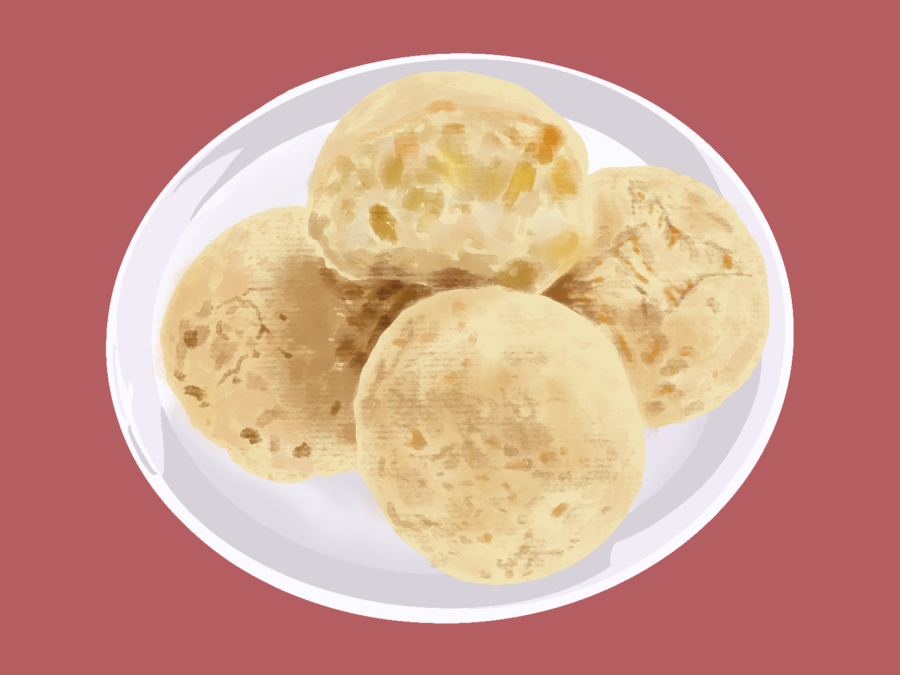Ecuadorian cheese bread and the silent labor of love
How my abuelita’s panes recipe helped me connect with my cultural heritage.
(Illustration by Julia Merchan)
May 3, 2023
I remember visiting my abuelitos’ place as a child in Sunnyside, Queens, running upstairs to their sunlit two-bedroom apartment. Though we only visited a few times a year, the apartment was a heritage haven. There, my younger self could connect with my Ecuadorian side, a part of myself I now feel distant from often.
Before high school, the only Spanish I understood was the brief phrases my abuelitos would greet me with like “mi nieta preciosa,” or “my lovely granddaughter” in English. I didn’t start speaking Spanish until I was 14, but by then, my abuelita and I had already established a way to communicate without words.
My abuelita expressed her love for her nietas through food. Of all the traditional Ecuadorian dishes my abuelita cooked, panes were by far my favorite. Panes directly translates to “breads,” and can refer to an array of dishes in various Hispanic cuisines. For me, panes are small rolls of cheese bread served plain, alongside lentils, or with any other Ecuadorian staples.
Since coming to NYU, I have searched for panes as good as my abuelita’s in supermarkets and Hispanic bakeries, but nothing comes close to the recipe she learned from her mother. I was 16 when I learned how to make my abuelita’s panes, in an attempt to connect with all aspects of my identity — including my cultural heritage.
As my abuelita headed to the kitchen to prepare, I silently followed her, watching as her hands firmly manipulated the dough. My own hands took copious notes.
My abuelita used no measurements and spoke minimal words as she baked the panes. I constructed this recipe myself, with my mom as my personal translator. The ingredient list is quite small, and as long as you can get your hands on tapioca starch, the rest of the ingredients are relatively easy to find. Although the ingredients for panes might be simple, the process of kneading the dough into a homogenous mixture can be laborious, requiring tricep strength and hours of work.
My abuelita doesn’t make panes anymore — her 85-year-old legs are too heavy for that much standing and her fragile fingers are too weak for hours of kneading. I don’t make panes that often either — my hands are usually typing assignments and flipping through textbooks instead.
Yet, every so often, I like to step away from my work and go to the kitchen. As my fingers crumble the cheese or knead the dough, I am reminded of my heritage, my abuelita and the work of her hands — hands that silently but tirelessly supported my own, molding panes and making way for my own opportunities.
If your hands need a break from studying, follow my abuelita’s recipe for cheese panes below.
Cheese Panes (Pan de Yuca)
Prep Time: 20-35 minutes
Cook Time: 25 minutes
Serving: 36 panes
Difficulty: The hardest part is kneading the dough — be prepared to work out!
Ingredients:
- 1 ¾ cups ricotta cheese
- 4 eggs
- 1 teaspoon baking soda
- 3 ¾ cups tapioca starch
- 2 pounds Ecuadorian cheese or shredded mozzarella
Instructions:
1. Preheat your oven to 400° F.
2. Put the ricotta, eggs and baking soda in a big bowl, and mix.
3. Gradually add in the cheese. If you’re using Ecuadorian cheese, crumble it in with your hands. Mix all the ingredients together until combined.
4. Gradually add the tapioca starch, kneading the dough with your hands until combined.
5. When the ingredients are combined, transfer the dough to a flat surface, and knead until smooth. This should take between 15 minutes and a half hour.
6. Separate the dough into 36 balls. A single ball should be able to fit into the palm of your hand, and should be about a half inch tall.
7. Place the dough on a baking sheet, the balls a few inches apart from one another, similar to how you would bake cookies.
8. Bake for 25 minutes or until the tops are golden brown.
Contact Tahra Khanuja at [email protected]



























































































































































